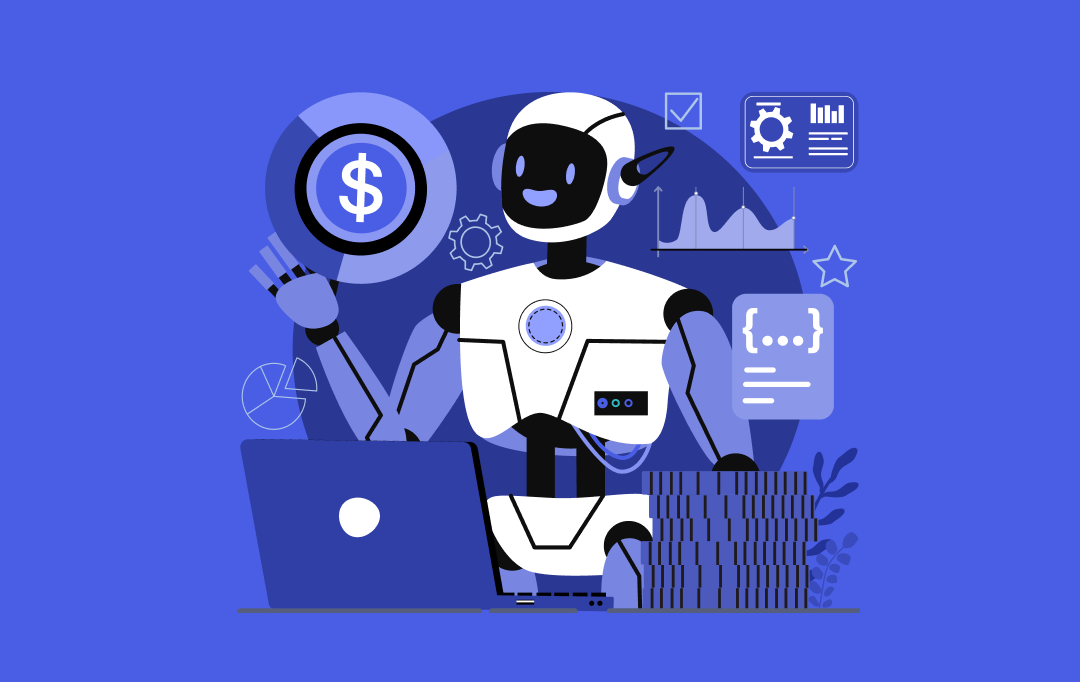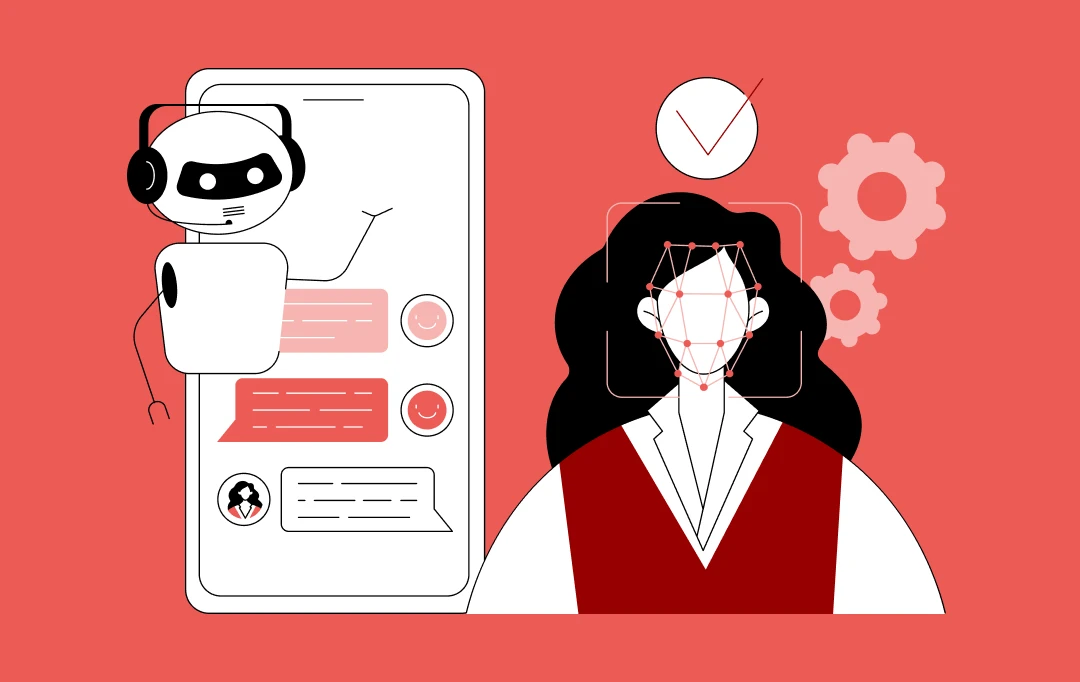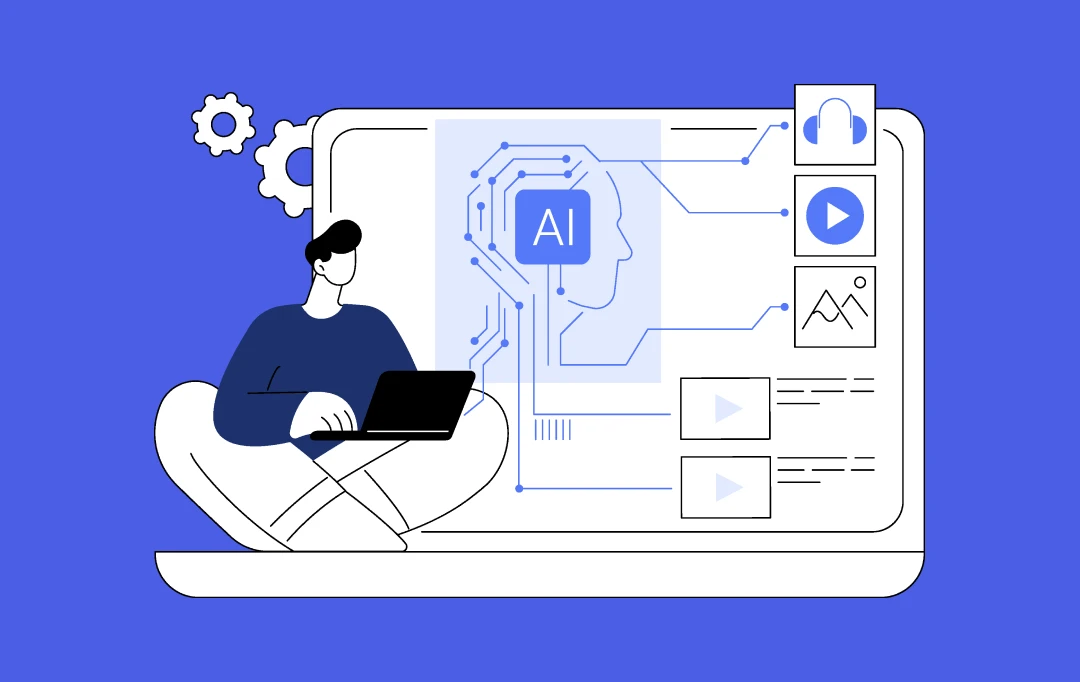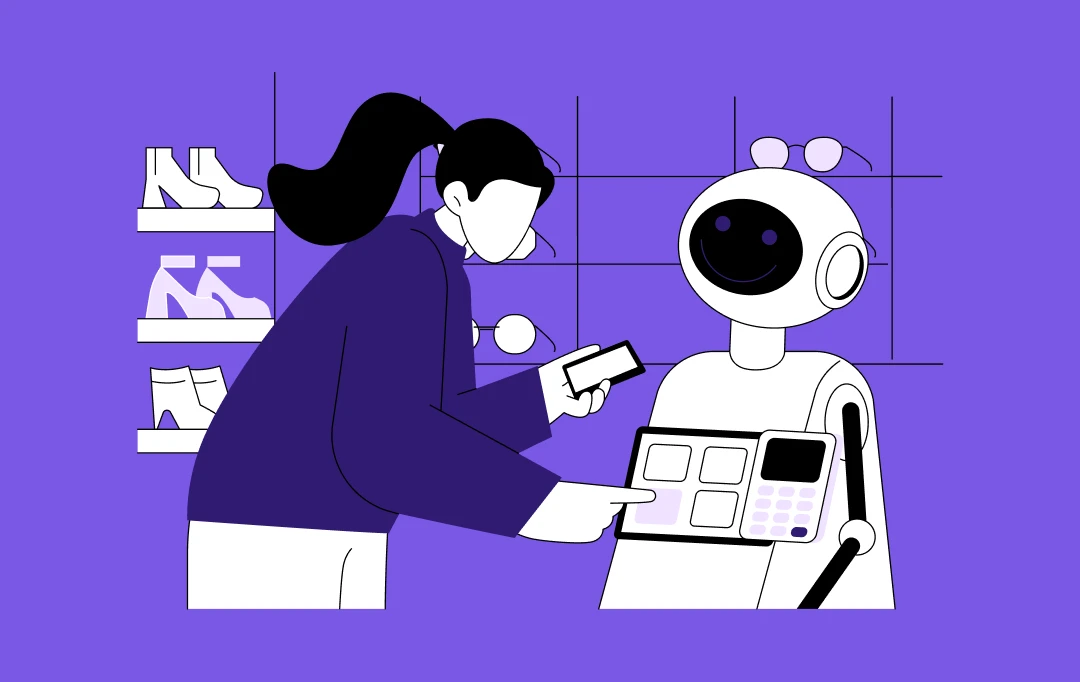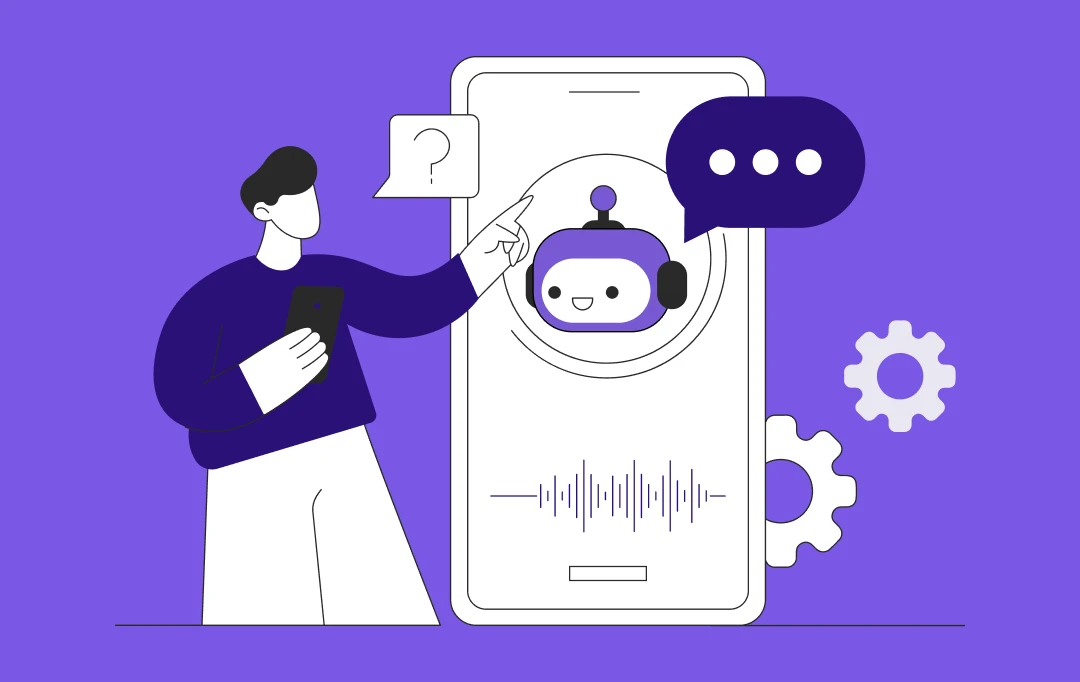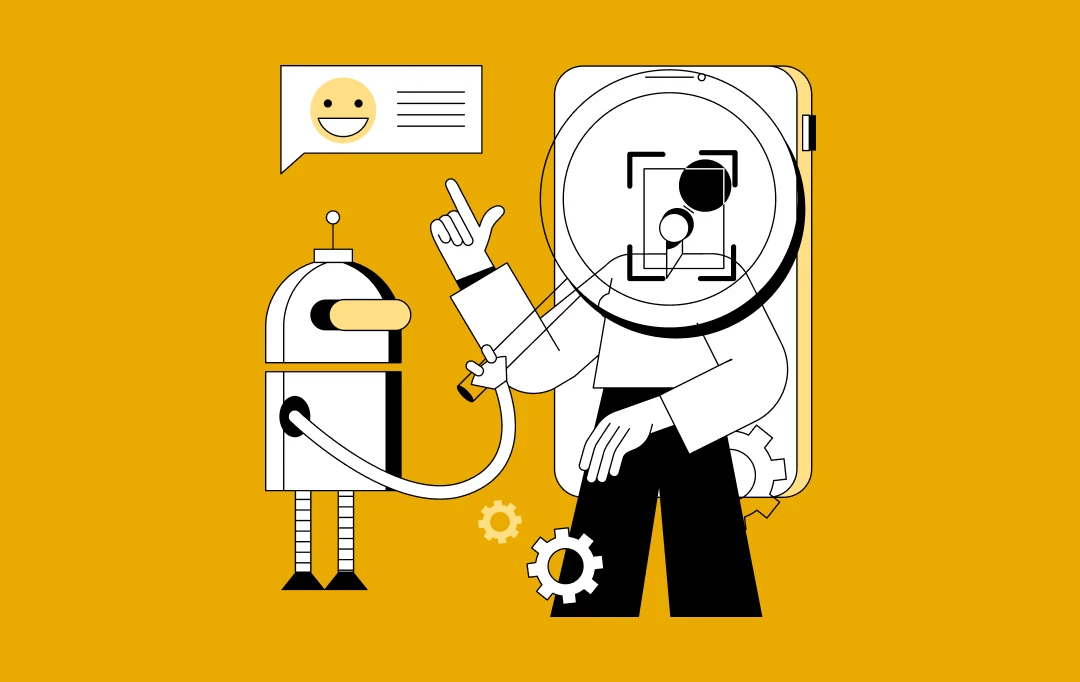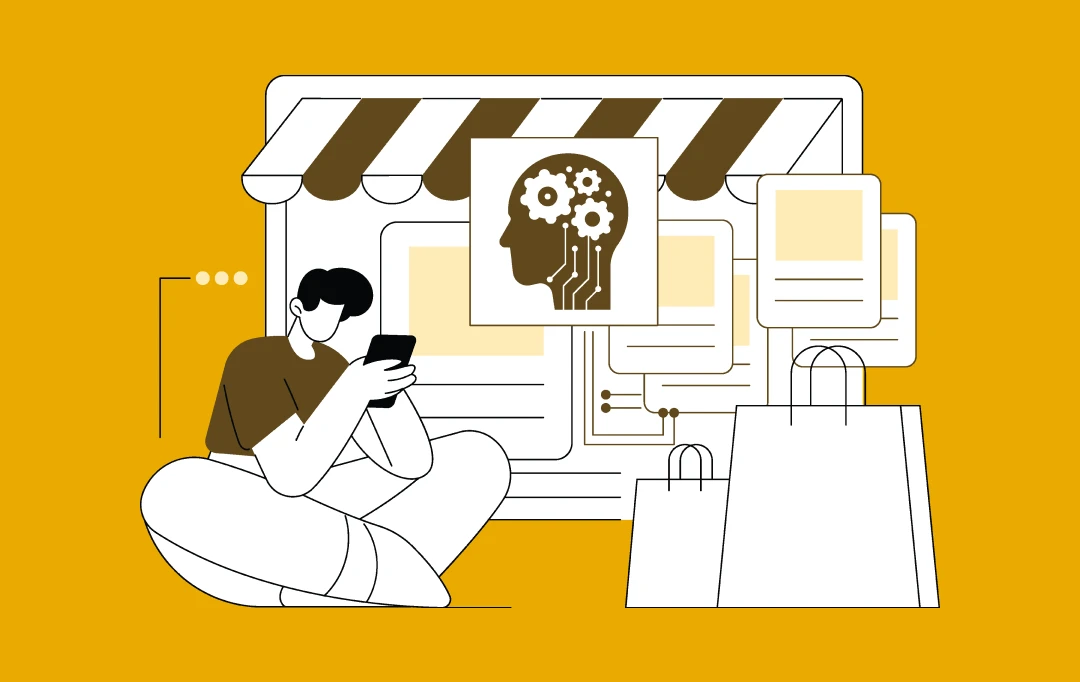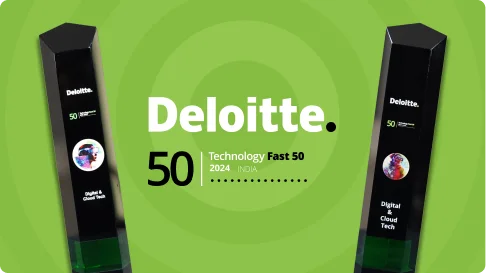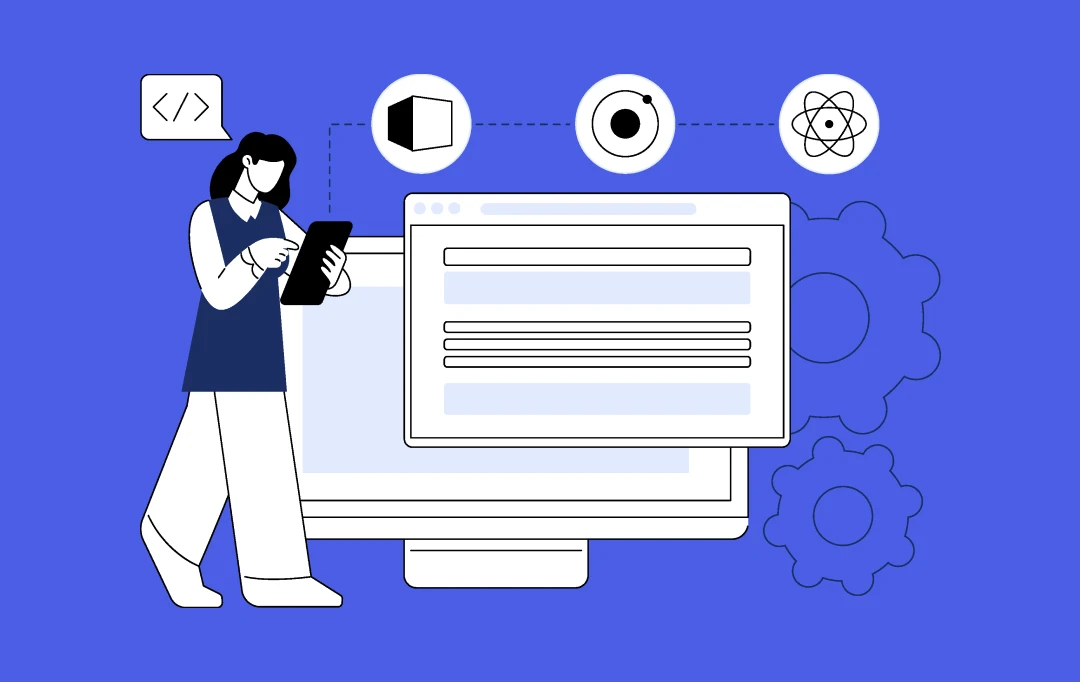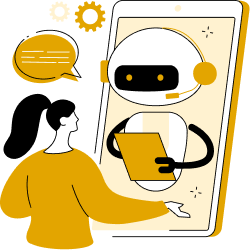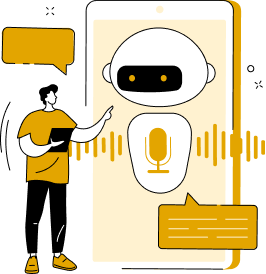- 10 Ways Wearable Chatbots Are Revolutionizing Human-Machine Interaction
- Voice-First Interaction: The Rise of Hands-Free Computing
- Continuous Health Monitoring with AI-Powered Insights
- Contextual Awareness and Personalized Responses
- Seamless Integration with Smart Home Ecosystems
- Real-Time Language Translation and Communication
- Proactive Wellness Coaching and Behavioral Modification
- Enhanced Accessibility and Assistive Technology
- Workplace Productivity and Professional Assistance
- Emotional Intelligence and Mental Health Support
- Predictive Analytics and Anticipatory Computing
- Addressing Wearable Chatbot Limitations and Charting the Path Forward
- Privacy Concerns:
- Device Compatibility:
- User Adoption:
- How Appinventiv Can Help You in Wearable App Development
- FAQs
Key takeaways:
- Enhanced User Interaction: Wearable AI chatbots enable hands-free, real-time, context-aware communication, driving user engagement and productivity.
- Proactive Health Monitoring: Continuous health tracking and personalized insights empower users to manage wellness effectively.
- Predictive AI: Wearables anticipate user needs with data-driven, contextual responses, improving customer experience.
- Smart Ecosystem Integration: Seamless integration with smart environments streamlines operations and enhances user connectivity.
Your customers expect wearables that don’t just track data but actively engage, anticipate needs, and integrate seamlessly into their workflows.
But here’s the reality check: A recent JMIR Publications’ study revealed that wearable device adoption increased to 36.36% from 28%-30% in 2019. While 78.4% of users are willing to share data with healthcare providers, only 26.5% do so. Wearable use is higher among females (OR 1.49), higher-income individuals (OR 2.65 for $50,000-$75,000; OR 3.2 for >$75,000), and younger users, with usage and data-sharing declining with age.
Hispanic respondents are more willing to share data than African American respondents (OR 1.92), but less likely actually to share (OR 0.44). Data sharing is predicted by more frequent provider visits (OR 1.23) and a greater number of medical conditions (OR 1.35). Higher wearable device use is associated with weight, frequent provider visits, technological self-efficacy, and regular physical activity.
Imagine a world where technology doesn’t just respond to you, it anticipates your needs, listens to your thoughts, and seamlessly integrates into your daily life. This isn’t a scene from a science fiction novel; it’s the emerging reality of AI chatbots in wearables.
“It’ll be unthinkable not to have intelligence integrated into every product and service. It’ll just be an expected, obvious thing.”
By Sam Altman, CEO of OpenAI
Wearable chatbots are a prime example of seamless integration of intelligence into our devices, making AI an “expected, obvious thing” in our lives. AI chatbots for wearable devices are evolving beyond basic functions to provide personalized, context-aware assistance, directly driven by smart glasses, rings, and other wearables.
For executives, this means unlocking new levels of productivity, enabling real-time decision-making, and enhancing user engagement, thereby redefining the way businesses and individuals connect with technology.
For instance, devices like Bee AI’s Pioneer bracelet and Omi’s head-worn gadget continuously process conversations around you, providing real-time summaries and actionable insights, effectively acting as personal assistants who are always on and attentive. (WIRED)
These innovations are not just about convenience; they’re about enhancing our interaction with the world. Researchers at the University of Maryland are developing advanced wearable devices that can sense and respond to their environment in real-time, potentially aiding in everything from disaster response to improving daily communications. (cs.umd.edu)
The expanding role of AI chatbot use cases in wearable devices is driving a transformative shift, moving beyond basic notifications to fully integrated, context-aware assistants that enhance health, productivity, and communication like never before. Keep reading to learn more:
10 Ways Wearable Chatbots Are Revolutionizing Human-Machine Interaction
The wearable AI market, including the rapidly expanding segment of AI chatbots in wearables, is witnessing robust growth fueled by seamless smartphone and IoT integration, rising health consciousness, and ongoing technological advancements. In 2024, the global wearable AI market was valued at USD 62.7 billion and is projected to reach USD 138.5 billion by 2029, expanding at a CAGR of 17.2% over the forecast period. The impact of wearable chatbots on consumer behavior and health management is evident as adoption accelerates globally, transforming how users engage with personal technology. [Source: MarketsAndMarkets]
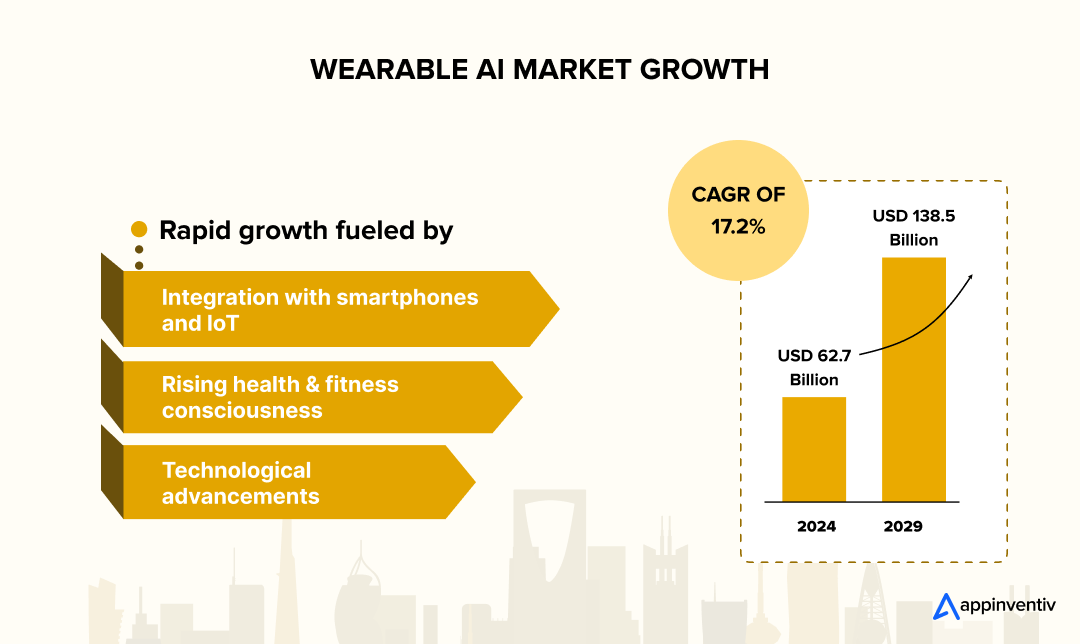
Recent innovations showcase the rapid evolution of this space. Apple’s groundbreaking Double Tap gesture, powered by the S9 processor’s neural engine, allows users to control their Apple Watch without touching the screen. Samsung’s revolutionary BioActive Sensor, which tracks Advanced Glycation End Products (AGEs), provides unprecedented insights into biological aging. Meanwhile, companies are integrating advanced AI models, such as,GPT-4 directly into wearable devices, creating more sophisticated conversational experiences. [Source: BGR]
Recent breakthroughs in AI chatbot integration in wearables have accelerated the development of smarter, more responsive devices.
As leaders driving innovation, you know we’re at a pivotal moment where AI breakthroughs and wearable technology are converging. Understanding how these forces are transforming the way we interact with machines today is key to positioning your business for a smarter, more connected future.
In this blog, we’ll explore the most impactful use cases of chatbots in wearable devices that are transforming daily life.

Voice-First Interaction: The Rise of Hands-Free Computing
Wearable devices are at the forefront of human-machine interaction, championing a voice-first approach. With AI chatbots in wearables, these devices enable seamless, hands-free communication. They leverage on-device AI to deliver faster, context-aware responses, facilitating a more natural and intuitive user experience. Unlike traditional devices that require manual input, wearable chatbots respond to natural speech, making interaction more intuitive and accessible. The rise of wearable AI chatbots for hands free communication is revolutionizing user interaction by enabling natural speech commands without requiring manual input.
Real Example:
Fitbit Labs by Google is utilizing generative AI to answer questions about athletic performance and provide advice relevant to users within specific contexts.
Must Read: AI Personal Assistant App Development Cost
The advancement of natural language processing (NLP) has made these interactions increasingly sophisticated. However, designing intuitive voice user interfaces requires careful consideration of user behavior patterns and conversational flow. Modern wearable chatbots can understand context, interpret emotions, and respond with appropriate actions.
- For the first time on Apple Watch, Siri requests can be processed on the device. For requests that do not require internet information, such as starting a workout or setting a timer, Siri does not rely on Wi-Fi or cellular networks, resulting in quicker and more reliable responses.
- Apple’s on-device Siri processing represents a significant leap forward in voice interaction. On the Series 9, you can now use Apple’s virtual assistant, Siri, to access and log your health information privately and securely. For example, you could ask Siri how your progress is looking on your Activity rings, how many hours of sleep you got last night, or what your average heart rate is when you’re taking a walk.
This capability transforms the smartwatch into a truly conversational health companion that can respond instantly without requiring internet connectivity.
Technical Innovation: Apple’s S9 SiP, featuring a 4-core Neural Engine, enables on-device processing that is twice as fast as previous generations, allowing for real-time voice recognition and natural language understanding directly on the wrist.
Bonus Read: How Can Google Voice Assistant App Make Your Business Efficient?
Continuous Health Monitoring with AI-Powered Insights
The healthcare sector stands as a prime illustration of the transformative potential of wearable chatbots. The increasing adoption of AI chatbots for wearable devices is revolutionizing health monitoring by delivering real-time, personalized insights. This empowers users to manage their wellness proactively. Advanced AI algorithms, analyzing user behavior, can identify preliminary indicators of stress, anxiety, or depression through subtle changes in sleep patterns, activity levels, and heart rate variability. The integration of syncing wearables with AI chatbots significantly enhances the accuracy of health data, enabling continuous analysis and personalized wellness feedback.
Beyond comprehensive health monitoring, key applications of AI chatbots in smart wearables extend to providing proactive, individualized wellness coaching.
Samsung’s latest innovation in this space is particularly noteworthy, reflecting broader trends in AI wearable implementation across different industries, from healthcare to fitness and beyond. The first of these features will be an Advanced Glycation End Products (AGEs) Index, an indicator of metabolic health and biological aging strongly influenced by overall lifestyle and dietary habits. [Source: Samsung]
- As an insightful biomarker, this index offers a snapshot of your biological age, enabling you to make more informed decisions about your wellness journey.
- The technical sophistication behind this monitoring is remarkable. With the new BioActive sensor, Samsung enhanced the performance of light-receiving photodiodes, increased the number of LEDs, and arranged them optimally across the sensor. Previously, the BioActive sensor needed eight photodiodes.
With the latest version, Samsung trimmed the number to four without affecting performance. This represents a significant engineering achievement in miniaturization while maintaining accuracy.
The integration of AI powered chatbots in wearable tech enables continuous health monitoring with real-time alerts and customized wellness recommendations. Modern wearable chatbots can also detect early warning signs of health issues. This capability aligns with how IoT in healthcare devices is revolutionizing patient monitoring through continuous data collection and analysis.
Technical Innovation: Samsung’s redesigned BioActive Sensor integrates Blue, Yellow, Violet, and Ultraviolet LEDs alongside traditional Green, Red, and Infrared LEDs, enabling 30% more accurate heart rate tracking during intensive workouts.
Contextual Awareness and Personalized Responses
Understanding the impact of wearable chatbots on enhancing personalized user experiences reveals their role in shifting from reactive devices to intelligent assistants that anticipate needs. This contextual awareness represents a quantum leap in human-machine interaction, moving beyond simple command-response patterns to intelligent, situational assistance.
One example of AI chatbot use cases in wearable devices is the Amazfit Active Edge. It is positioned as one of the most advanced smart watches, thanks to the integration of the language model GPT-4 from OpenAI. This device combines a robust design with AI technology to provide a seamless and personalized user experience.
These devices leverage multiple data sources, including GPS location, heart rate, movement patterns, calendar information, and environmental sensors to understand what users need before they even ask.
Apple’s implementation is particularly sophisticated.
- The Neural Engine processes data from the accelerometer, gyroscope, and optical heart sensor with a new machine learning algorithm. The algorithm detects the unique signature of tiny wrist movements and changes in blood flow when the index finger and thumb perform a double tap.
The personalization capabilities extend beyond health metrics. Wearable chatbots can learn individual communication preferences, frequently used applications, and daily routines to provide increasingly relevant suggestions.
- The Galaxy AI’s personalized Energy Score provides a data-driven assessment of an individual’s daily physical readiness. This metric is intelligently derived from an analysis of the previous day’s activities, offering a proactive insight into optimal performance capacity for the day ahead.
Technical Innovation: Apple’s Double Tap gesture uses machine learning algorithms to analyze minute changes in blood flow and muscle movements, thereby creating a unique biometric signature for gesture recognition.
Bonus Read: How AI and IoT are Transforming Businesses
Seamless Integration with Smart Home Ecosystems
AI chatbots in wearables are redefining how users interact with their connected environments. These intelligent assistants transform wearables into central hubs within smart home ecosystems, enabling seamless management through intuitive voice and gesture commands. This strategic integration elevates wearables from mere personal devices to powerful orchestrators of the connected world.
Users are increasingly relying on wearable AI chatbots for hands free communication to effortlessly control their smart homes. This chatbot powered wearable tech facilitates a direct and intuitive interface with various smart devices. For instance, advanced voice assistants like Apple’s Siri and Google Assistant are continually evolving, enabling users to execute complex tasks such as setting reminders, sending messages, and controlling home appliances with simple verbal commands. This shift empowers users with a streamlined and efficient way to manage their digital and physical surroundings.
The integration extends beyond basic control to intelligent automation. This reflects broader trends in IoT and chatbot development, where conversational interfaces become central to device management.
- Wearable chatbots can learn from user patterns and automatically adjust environmental settings based on preferences, time of day, and detected activities.
- The Apple Watch Series 10 features the S10 SiP, Apple’s most powerful watch chip yet, along with a 4-core Neural Engine that enables sophisticated on-device processing for features such as faster Siri interactions and complex machine learning tasks, thereby enhancing smart home automation scenarios.
Smart wearables with AI chatbots are transforming smart home management by serving as intuitive central hubs. These devices empower users to control their connected environments through voice and gesture commands effortlessly.
For instance, the Apple Watch Series 10 exemplifies this capability. Its 4-core Neural Engine efficiently processes machine learning tasks, enabling seamless smart home interactions. The power efficiency of the S10 SiP ensures an all-day 18-hour battery life, providing uninterrupted control without concerns of depletion. Additionally, the Series 10 boasts faster charging, reaching 80% in approximately 30 minutes. This optimized performance ensures that syncing wearables with AI chatbots delivers reliable and convenient smart home automation through voice commands and automated routines.
Technical Innovation: Ultra Wideband (UWB) technology in modern smartwatches enables precise spatial awareness, allowing devices to understand their location within smart homes and provide context-aware automation.
Real-Time Language Translation and Communication
The advances in chatbot technology for wearable devices enable real-time language translation with on-device neural processing, ensuring privacy and reducing latency in multilingual conversations. These devices can instantly translate speech or text between multiple languages, enabling seamless communication across linguistic boundaries in real-time discussions.
Wearable devices powered by chatbot assistants are fundamentally transforming global communication by providing real-time, on-device language translation. This capability transcends basic word-for-word exchanges. Modern systems utilize advanced neural machine translation, which accounts for context, cultural nuances, and conversational flow, to deliver highly accurate and natural translations. This strategic integration of AI into wearable devices with AI chatbot support empowers seamless cross-cultural interaction, directly impacting global collaboration and market accessibility.
This technology is particularly valuable for travelers, international business professionals, and individuals working in multicultural environments. The integration of Voice AI chatbots in smartwatches enables seamless, real-time language translation, instantly breaking down communication barriers. The convenience of having instant translation capabilities on the wrist eliminates the need for separate translation apps or devices.
- AI-powered smart earbuds are becoming increasingly intelligent, integrating real-time language translation, voice coaching, and health tracking, demonstrating how translation capabilities are expanding across the entire wearable ecosystem.
- The processing power required for real-time translation is now becoming available in wearable form factors. It features a five-core CPU, comprising one Cortex-A78 core and four Cortex-A55 cores.
Samsung claims it can launch apps 2.7 times faster and is 30% more power-efficient, providing the computational resources needed for complex language processing tasks.
Technical Innovation: On-device neural processing units in modern smartwatches can perform real-time translation without requiring cloud connectivity, ensuring privacy and reducing latency in conversational scenarios.
Do Have A Read At: AI in the Payments Industry: Tools, Use Cases, and Challenges
Proactive Wellness Coaching and Behavioral Modification
Advanced AI chatbots for wearable systems act as virtual personal trainers, offering behavioral nudges and customized coaching to support healthier lifestyle choices. Unlike traditional fitness trackers that simply record data, these AI-powered companions analyze patterns, provide personalized recommendations, and motivate users toward healthier choices through intelligent interaction.
The coaching capabilities extend across multiple wellness dimensions, including physical activity and nutrition. This aligns with how mobile health applications are transforming fitness through personalized, data-driven approaches. Samsung Galaxy Watch 7 focuses on customized wellness. It gives detailed reports on your sleep and activity. This helps you to improve your health. The interface is easy to use. AI features let you stay connected.
Bonus Read: Cost to Build a Fitness App like Fitbod
These systems utilize principles of behavioral psychology to encourage positive changes. They can identify when users are likely to skip workouts, suggest healthy meal options based on dietary preferences and goals, or recommend stress-reduction techniques when elevated stress levels are detected. Many wearable devices with AI chatbot support now offer personalized wellness coaching, using real-time data to motivate healthier habits.
- Samsung’s approach to wellness coaching includes sophisticated metabolic tracking. The Galaxy Watch 7 can also perform Advanced Glycation End Products (AGEs) Index tracking while you sleep, something that sets it apart from most other wellness wearables. AGEs are an indicator of metabolic health and biological aging, informed by lifestyle and dietary habits.
- Corporate wellness programs are increasingly incorporating wearable chatbot technology, recognizing their potential to improve employee health outcomes while reducing healthcare costs.
If you struggle with consistency, expect gentle nudges – your smartwatch might remind you that your heart rate suggests you could push a little harder, or that today’s a good day for a rest session.
Technical Innovation: Machine learning algorithms can now predict optimal workout timing based on sleep quality, stress levels, and historical performance data, creating truly personalized fitness coaching experiences.
Enhanced Accessibility and Assistive Technology
For users with disabilities, Voice AI chatbots in smartwatches provide critical voice-controlled assistance, improving independence and usability. These devices serve as bridges between users and the digital world, offering alternative interaction methods. Advances in the smart integration of AI chatbots in wearables have significantly improved accessibility features for users with disabilities.
Must Read: AI in HR
For individuals with visual impairments, wearable chatbots can provide audio descriptions of surroundings, read text aloud, and offer navigation assistance through voice-guided directions.
- The voice-first interaction model eliminates the need for visual interfaces, while haptic feedback provides additional sensory information. While AssistiveTouch can play a similar role to this feature, it doesn’t allow for as much variety in the control as the user has with a single gesture.
- Apple’s Double Tap technology represents a significant advancement in accessibility. The double tap gesture is helpful in common situations when the user’s other hand is occupied, such as when walking the dog, cooking, or holding a cup of coffee.
This capability is particularly valuable for individuals with motor impairments who may struggle to use traditional touch interfaces.
Motor impairments are addressed through voice control and gesture recognition, enabling users to operate devices without relying on fine motor skills. On compatible Apple Watch models, tap your index finger and thumb together twice to perform common actions. This simple gesture can replace complex touch interactions that may be challenging for users with limited mobility.
The cognitive assistance capabilities are particularly valuable for individuals with memory impairments or mental disabilities.
- Wearable chatbots can provide medication reminders, appointment notifications, and step-by-step guidance for daily tasks. Double tap allows users to select the primary action in a wide variety of watchOS apps and notifications, including: Opening the Smart Stack from any watch face and scrolling through widgets in the stack.
Technical Innovation: Advanced gesture recognition, utilizing accelerometer, gyroscope, and optical heart rate sensor data, enables the precise detection of subtle hand movements, providing alternative input methods for users with mobility challenges.
Workplace Productivity and Professional Assistance
Modern workplaces are embracing chatbot powered wearable tech to deliver hands-free access to emails, schedules, and critical data, keeping professionals connected on the go. This trend reflects the broader adoption of enterprise ai software solutions for productivity enhancement across various industries. Industries are adopting intelligent chatbot assistants in wearable gadgets to boost efficiency, enabling hands-free access to essential data and real-time collaboration.
Professional applications include voice-activated email management, calendar scheduling, quick access to company databases, and real-time collaboration with team members. Modern workplaces benefit from AI powered chatbots in wearable tech by enabling hands-free access to essential data, improving efficiency for mobile professionals.
- Google Pixel Watch 3 brings Google’s services to your wrist. It connects you to your favorite apps. Fitbit powers health features. They give you a complete view of your fitness. This integration demonstrates how wearable devices are becoming comprehensive productivity platforms that connect seamlessly with existing workflow tools.
Several applications of AI chatbots in smart wearables focus on improving workflow efficiency and hands-free access to enterprise data. They can provide meeting reminders, summarize important communications, track project milestones, and even facilitate language translation in international business contexts.
- New for 2025, the OnePlus Watch 3 is a fantastic addition to the Wear OS smartwatch lineup. It builds on the very successful formula of our previous pick, the OnePlus Watch 2, with its bold, chunky design, impressive AMOLED display, and leading battery life.
Industries are recognizing the potential for wearable chatbots to improve operational efficiency. These implementations mirror real-world AI integration examples where companies achieve significant productivity gains through intelligent automation. In manufacturing environments, these devices can provide hands-free access to safety procedures, equipment manuals, and quality control checklists. Healthcare workers can access patient information, medication databases, and clinical protocols without compromising sterile procedures or patient care.
Technical Innovation: 5G connectivity in premium smartwatches enables real-time access to enterprise cloud services, allowing workers to access complex databases and applications directly from their wrist.
Emotional Intelligence and Mental Health Support
Emerging chatbot technology for wearable devices incorporates emotional recognition and mental health support, offering personalized interventions based on biometric signals and user behavior. These advances represent significant technology innovations in mental health support, offering new ways to monitor and address psychological well-being. Emerging trends show wearable devices powered by chatbot assistants are playing a crucial role in mental health support by detecting stress and delivering timely interventions.
The emotional recognition capabilities combine multiple data sources, including heart rate variability, voice analysis, movement patterns, and user interactions, to assess emotional states. When signs of stress or anxiety are detected, the wearable chatbot can suggest breathing exercises, meditation techniques, or recommend taking breaks. Among the notable benefits of AI chatbots in wearables is their role in monitoring emotional well-being and offering timely mental health support.
Must Read: AI in Mental Health
Emerging smart wearables with AI chatbots are enhancing mental wellness by monitoring emotional states and providing timely interventions. These systems can also provide cognitive behavioral therapy (CBT) techniques, mindfulness exercises, and mental health check-ins through conversational interfaces. The always-available nature of wearable devices makes them ideal platforms for delivering mental health support when and where it’s needed most.
- Advanced sensors enable sophisticated stress monitoring. This enables the new BioActive Sensor to more accurately measure key health metrics, including heart rate, sleep quality, blood pressure, blood oxygen levels, and stress levels. Even the measurement of heart rate during intensive workouts is 30% more accurate compared to its predecessor.
- Mental health professionals are beginning to incorporate data from wearable chatbots into their practice, using objective physiological and behavioral data to supplement traditional assessment methods.
The ability to track mood patterns, sleep quality, activity levels, and stress indicators over time provides valuable insights for personalized treatment approaches.
Technical Innovation: Multi-spectral optical sensors combined with machine learning algorithms can detect subtle physiological changes associated with emotional states, enabling proactive mental health interventions.
Predictive Analytics and Anticipatory Computing
The next generation of chatbot technology for wearable integrates predictive analytics to forecast user needs, enhancing proactive health and lifestyle management. This represents the future of integrating AI technologies for business intelligence and proactive decision-making. This means the pinnacle of human-machine interaction evolution, moving from reactive responses to anticipatory computing that enhances daily life through intelligent prediction.
Predictive analytics in wearable chatbots analyzes patterns in user behavior, environmental conditions, physiological data, and contextual information to forecast future needs. AI is poised to enhance your smartwatch, smart ring, and other wearables, introducing new features such as advanced fitness tracking. AI is improving at recognizing individual fitness levels and adjusting recommendations in real-time.
Health predictions are particularly valuable, as wearable chatbots can identify potential health issues before symptoms become apparent. Imagine for a second your smartwatch detecting subtle changes in your heartbeat over time, warning you about potential arrhythmia risks before they become dangerous. Or an AI-driven feature that notices irregular breathing patterns at night and flags early signs of sleep apnea.
The anticipatory computing capabilities extend to productivity and lifestyle management. Wearable chatbots can predict optimal meeting times based on energy levels and schedule patterns, suggest the best routes based on traffic predictions and personal preferences, or recommend activities based on weather forecasts and past behavior patterns.
- Models with advanced reasoning capabilities, such as OpenAI o1, can already solve complex problems using logical steps that are similar to how humans think when responding to difficult questions.
- Samsung’s latest devices showcase advanced predictive capabilities. Samsung says heart rate accuracy during intensive workouts has improved by 30% compared to the Galaxy Watch 6. The new smartwatch, similar to previous-generation Galaxy Watches, can analyze your body composition, measure electrocardiograph (ECG), and track your sleep. This enhanced accuracy enables more reliable predictive health insights.
Technical Innovation: Edge AI processing with dedicated neural processing units enables real-time analysis of complex behavioral patterns, allowing wearable devices to make intelligent predictions without relying on cloud connectivity.
Addressing Wearable Chatbot Limitations and Charting the Path Forward
Wearable chatbots promise a future of seamless, personalized assistance. Despite the benefits of AI chatbots for wearable devices, user adoption can be slow due to concerns around privacy, usability, and perceived value, challenges that the industry is actively addressing. Advancements in intelligent chatbot assistants in wearable gadgets focus on overcoming privacy and compatibility challenges to enhance user trust and adoption.
Overcoming challenges related to AI chatbot integration in wearables involves improving interoperability and ensuring user privacy.
Privacy Concerns:
Limitation
Expanding the use cases of chatbots in wearable technology depends on resolving privacy concerns and enhancing device compatibility. Wearable chatbots constantly collect highly personal data (conversations, health metrics, location, and even emotional states). This raises significant concerns about data ownership, usage, and potential for misuse or surveillance.
Solution

Device Compatibility:
Limitation
The fragmented landscape of wearable devices, operating systems, and ecosystems can lead to compatibility issues. A chatbot designed for one platform might not function seamlessly on another, hindering widespread adoption. Research indicates that 73% of users cite compatibility issues as a major deterrent when considering wearable technology.
Solution:
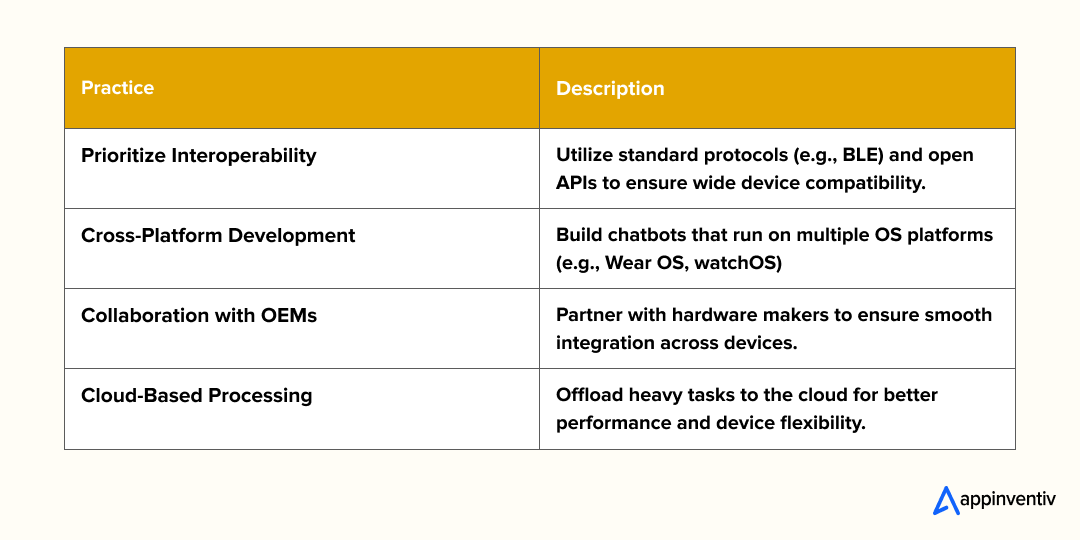
User Adoption:
Limitation
Effective smart integration of AI chatbots in wearables is key to overcoming adoption barriers by delivering clear, user-friendly benefits. Despite the potential benefits, user adoption can be slow due to various factors, including a lack of perceived value, skepticism about AI capabilities, complex user interfaces, or concerns about “always-on” monitoring. Users may also find that current chatbot interactions feel less human and empathetic.
Solution:

How Appinventiv Can Help You in Wearable App Development
Appinventiv stands out as a leading AI chatbot development company, offering end-to-end services tailored to the unique demands of the wearable technology landscape. With the rapid growth of wearable devices and the increasing demand for intelligent, voice-first, and context-aware applications, partnering with a specialized developer like Appinventiv can be a game-changer for businesses looking to innovate in this space.
At Appinventiv, the journey of developing a wearable app begins with a thorough understanding of your specific business objectives and the needs of your target users. Their expert team offers comprehensive wearable app development services, specializing in creating custom applications that seamlessly integrate AI chatbots. This integration facilitates natural, hands-free interactions and delivers highly personalized user experiences.
A prime example of their innovative approach is the Vyrb case study. Appinventiv partnered with Innovative Eyewear to revolutionize social media interaction through voice commands on Bluetooth wearables. Vyrb allows users to create, listen to, and comment on social media posts hands-free, integrating seamlessly with voice assistants like Siri and Google Assistant. This project showcased Appinventiv’s ability to overcome technical challenges and deliver a novel, engaging experience that redefined how users interact with social media through wearable technology.
Finally, Appinventiv offers continuous post-launch support, analytics integration, and AI model updates to keep your wearable app intelligent, responsive, and ahead of market trends.
Don’t just keep up with wearable tech—set the pace. Reach out to Appinventiv and innovate without limits!
FAQs
Q. What are the challenges of integrating AI chatbots in wearables?
A. Integrating AI chatbots into wearables faces challenges, including data privacy concerns due to the constant collection of sensitive personal information. Device compatibility is another hurdle, as the fragmented wearable ecosystem complicates seamless chatbot functionality across platforms. User adoption can be slow due to complex interfaces, skepticism about AI accuracy, and concerns about “always-on” monitoring. Additionally, the limited processing power and battery life in wearables constrain the performance of sophisticated AI chatbots, requiring efficient on-device optimization and cloud integration.
Q. What are the advantages of AI chatbots in wearable technology?
A. AI chatbots in wearable technology offer numerous advantages, including hands-free, natural interaction that enhances user convenience. They provide real-time health monitoring with personalized insights, enabling proactive management of wellness. These chatbots enhance productivity by providing instant access to information and enabling smart ecosystem control. Additionally, they enhance accessibility for users with disabilities through voice and gesture interfaces. Their ability to anticipate user needs and deliver context-aware responses creates a more intuitive and connected user experience overall.
Q. How wearable chatbots improve human-machine interaction?
A. Wearable chatbots improve human-machine interaction by enabling seamless, hands-free communication through natural voice and gesture controls. They provide personalized, context-aware responses by analyzing real-time data from sensors, making interactions more intuitive and efficient. By integrating with smart ecosystems, wearable chatbots allow users to manage devices effortlessly. Their continuous monitoring and predictive capabilities anticipate user needs, transforming wearables from simple gadgets into intelligent companions that enhance daily life and productivity.
Q. How AI wearable chatbots enhance user experience?
A AI wearable chatbots enhance user experience by offering personalized, real-time assistance through natural voice and gesture interactions. They continuously monitor health and activity data to provide tailored insights and proactive recommendations. By seamlessly integrating with smart devices and ecosystems, these chatbots simplify daily tasks and improve accessibility. Their ability to anticipate needs and deliver context-aware support creates a smooth, intuitive, and hands-free user experience, making technology more responsive and engaging.


- In just 2 mins you will get a response
- Your idea is 100% protected by our Non Disclosure Agreement.
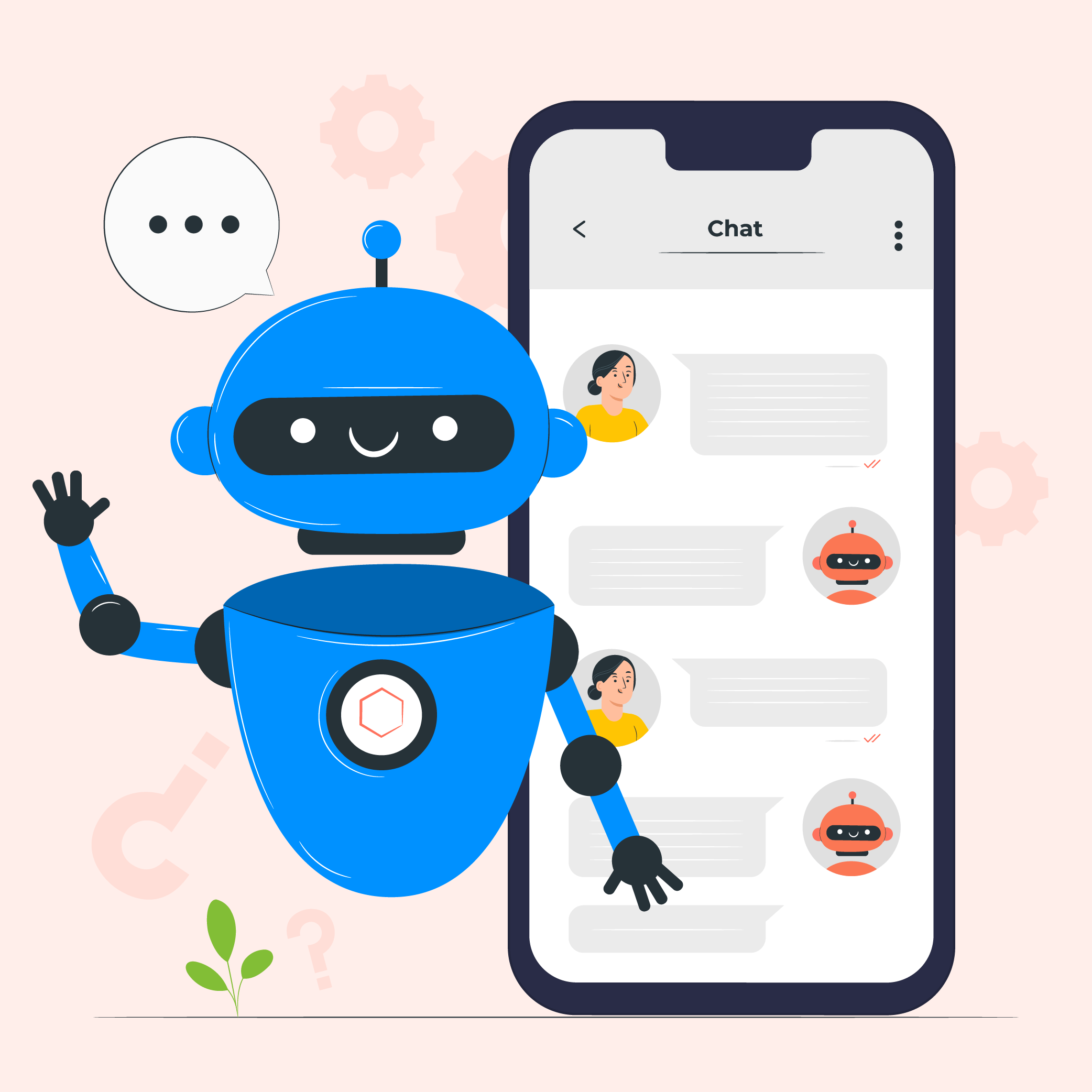
How to Build A Chatbot with Deep NLP?
Earlier,chatbots used to be a nice gimmick with no real benefit but just another digital machine to experiment with. However, they have evolved into an indispensable tool in the corporate world with every passing year. Developing and maintaining a chatbot is, of course, a time, effort and money draining job. Yet, compelling businesses, new and…

How Much Does it Cost to Develop A Chatbot?
The modern-day business world has found a number of uses for chatbots. From increasing the user engagement count to play a major part in the lead conversion process, chatbots have entered the world across industries. The fact that chatbots are equally famous among baby boomers and millennials, increases the user base of the technology to…

How Chatbot Development is Shaping The Business Growth Story
My mother recently booked an Air India flight through a leading travel website. After booking the flight that suited her, she got a message on WhatsApp from the site, with her flight’s PNR number: A Chatbot Application doing. Now being a part of a company that specializes in Chatbot App Development, my interaction with the…
